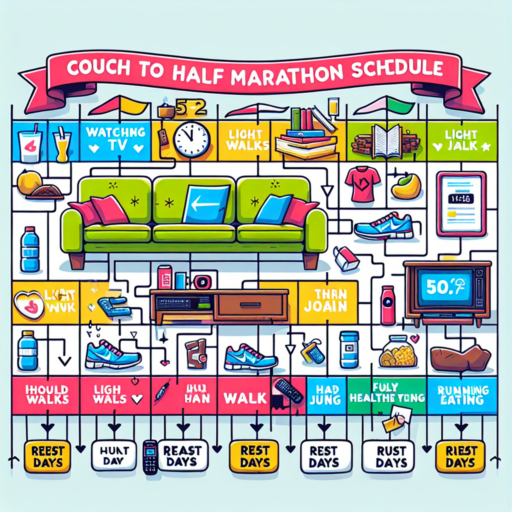How long do you need from couch to half marathon?
Transitioning from a sedentary lifestyle to running a half marathon is an admirable but challenging goal. The time needed to prepare for such an endeavor varies significantly based on several factors, including your current fitness level, running experience, and personal health conditions. Most standard training plans suggest a preparation period ranging from 12 to 20 weeks for novice runners. This timeframe allows for a gradual increase in mileage, helping to build endurance while minimizing the risk of injury.
Starting with shorter, more manageable runs is crucial for beginners. Initially, focusing on consistency over distance is more beneficial. A typical week during the early stages of training might include three to four runs, starting with 1-2 miles and gradually increasing weekly. This slow build helps accustom the body to the physical demands of running longer distances. Incorporating rest days and cross-training activities, such as cycling or swimming, can also enhance overall fitness and recovery.
Listening to your body throughout the training process cannot be overstressed. While pushing yourself is necessary for improvement, acknowledging the signs of overtraining and allowing adequate recovery time is equally important. Personalization of training plans to fit one’s individual needs and lifestyle is often the key to successfully completing a half marathon. Whether it takes 12 weeks or 20, the journey from couch to half marathon is a test of physical and mental endurance, culminating in a rewarding achievement.
Can I go from couch to half marathon in 12 weeks?
Embarking on the journey from being a couch potato to running a half marathon in just 12 weeks is a considerable challenge. It requires not only a significant physical transformation but also a dedicated mindset. The good news is, with the right training plan and approach, it’s entirely achievable for many individuals. However, it’s crucial to tailor your training plan to your current fitness level to reduce the risk of injury and ensure consistent progress.
Understanding Your Starting Point
Before diving into any training plan, it’s essential to evaluate your current fitness level. If you’re starting with minimal to no exercise routine, your primary focus should be on building a base level of cardio fitness and gradually increasing your running distance. Incorporating running and walking intervals can be an effective way to start, allowing your body to adapt without becoming overwhelmed.
Crafting a Focused Training Plan
The backbone of preparing for a half marathon in a shortened timeframe is a structured training plan. This plan should encompass not only regular running sessions but also strength training and rest days to aid recovery. Adhering to a well-balanced training schedule is pivotal. It should incrementally increase your running distance each week while ensuring you have adequate recovery time to avoid burnout and injuries. Listening to your body and making adjustments as needed is equally vital for success.
No se han encontrado productos.
How many rest days before a half marathon?
The optimal number of rest days before a half marathon can significantly influence your performance and overall experience during the race. It’s a common question among runners, both novice and experienced, as finding the right balance between training and rest can be key to ensuring you’re at your best on race day. Typically, it is suggested to take about 2-3 rest days immediately before the event, allowing your body to fully recover and store energy.
Understanding the Tapering Process
Tapering is a critical phase in your training regimen where you gradually decrease the volume of your running to allow your body time to rest and repair before the big day. During the last week leading up to the half marathon, your running workload should be significantly reduced. Incorporating 2-3 rest days in this week is ideal, with some runners opting for light, short runs or completely taking off from running to ensure full muscle recovery and glycogen replenishment.
It’s also worth noting that resting doesn’t mean a complete halt in physical activity. Active recovery, such as walking or gentle stretching, could be beneficial during your rest days. These activities can help maintain your mobility without placing undue stress on your body, ensuring you’re not only rested but also limber and ready for the race. Consequently, strategically planning your rest days before a half marathon is crucial for achieving optimal performance.
How to train for a half marathon from a couch?
Transitioning from a sedentary lifestyle to preparing for a half marathon can seem like a daunting task. However, with the right approach, it’s entirely achievable. Here’s how to kickstart your training journey from the comfort of your couch.
Embark on a Pre-Training Fitness Regimen
Before you dive into a half marathon training schedule, it’s imperative to build a basic level of fitness. Start with low-impact exercises such as walking, swimming, or cycling. Aim for at least 30 minutes of activity a day, gradually increasing the intensity and duration over several weeks. This pre-training phase is crucial for conditioning your body and preventing injuries.
Create a Structured Training Plan
Once you’ve built a foundational level of fitness, it’s time to adopt a more structured training plan. A well-rounded half marathon training program should include a mix of running, strength training, and rest days to allow your body to recover. Start with short, manageable runs, and progressively increase your distance each week. Incorporating interval training can also help improve your stamina and speed.
Remember, transitioning from a sedentary lifestyle to running a half marathon is a gradual process. Listen to your body, and don’t hesitate to adjust your training plan as needed. With consistency and determination, crossing that half marathon finish line is within your reach.




